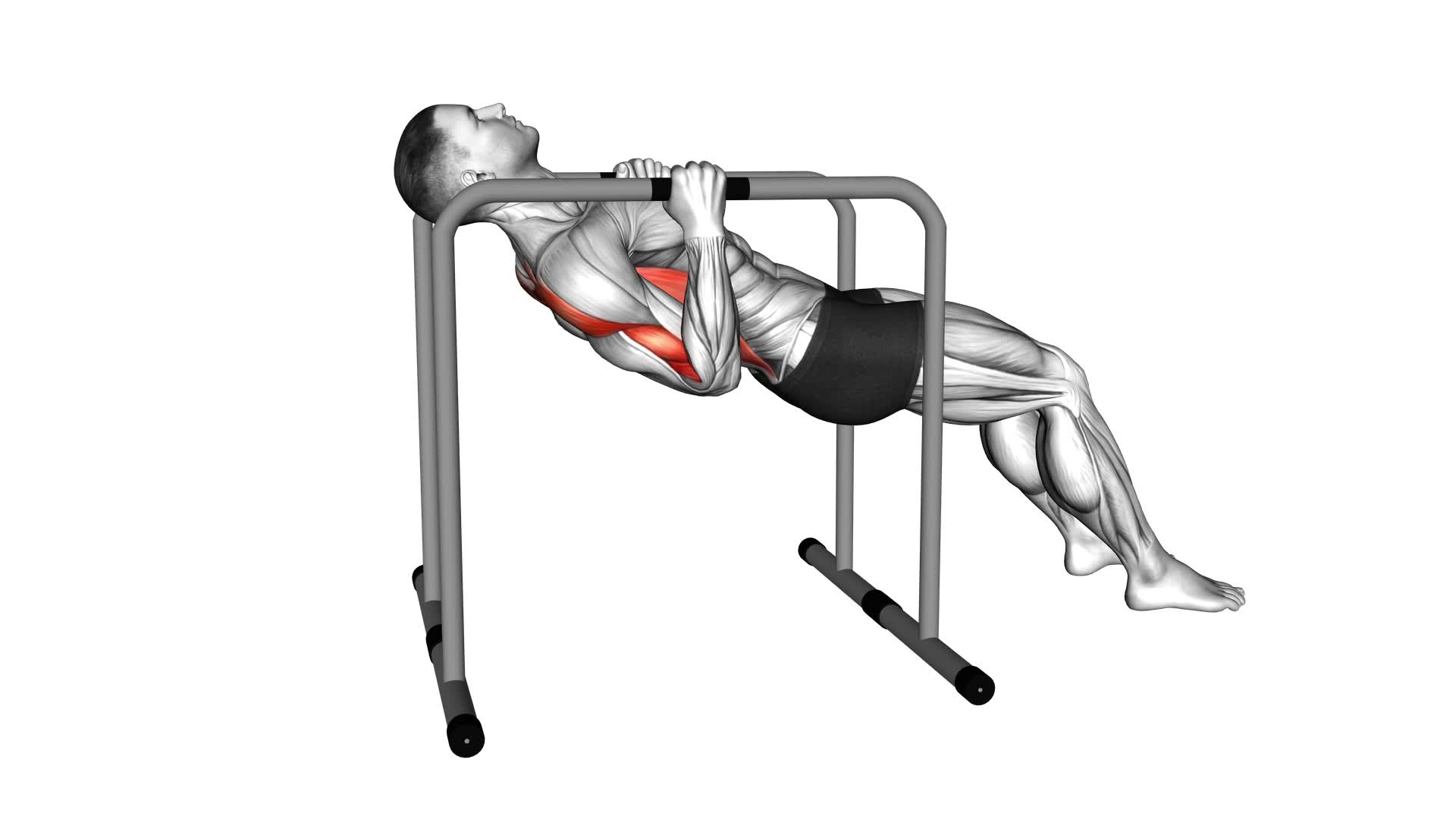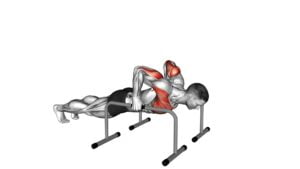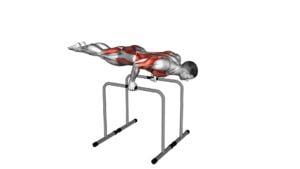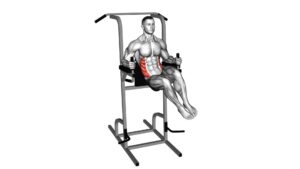Parallel Bars Bent Knee Inverted Row (male) – Video Exercise Guide & Tips

Are you looking to build strength and improve your upper body?
Watch This Exercise Video
Then the Parallel Bars Bent Knee Inverted Row is the exercise for you.
In this video exercise guide, we'll show you the proper form and technique, along with variations and progressions to challenge yourself.
With the right equipment and our tips for maximizing results, you'll be on your way to achieving your fitness goals in no time.
Get ready to take your workout to the next level with this effective exercise.
Key Takeaways
- Strengthens upper body
- Improves posture
- Targets back, shoulders, and arms
- Activates latissimus dorsi muscles (lats)
Benefits of the Parallel Bars Bent Knee Inverted Row
Experience the numerous benefits of the Parallel Bars Bent Knee Inverted Row as you strengthen your upper body and improve your posture. This exercise specifically targets the muscles in your back, shoulders, and arms, making it an excellent choice for building upper body strength.
Muscle activation during the parallel bars bent knee inverted row is significant. This exercise primarily activates the latissimus dorsi muscles, commonly known as the lats, which are the largest muscles in your back. Additionally, your biceps, rhomboids, and rear deltoids are also engaged during this exercise. By working these muscles, you can develop a strong and defined upper body.
The role of body positioning is crucial in the parallel bars bent knee inverted row. To perform this exercise effectively, you must position yourself correctly. Begin by gripping the parallel bars with your palms facing away from you. Your body should be straight, with your knees bent and your feet resting on the floor. As you pull your chest towards the bars, focus on keeping your core engaged and your shoulders pulled back. Maintaining proper body positioning ensures that you're targeting the intended muscles and maximizing the benefits of this exercise.
Equipment Needed for the Exercise
To perform the Parallel Bars Bent Knee Inverted Row, you'll need a set of parallel bars. These bars provide stability and support for executing the exercise correctly. Here are some other equipment options you can consider for this exercise:
- Parallel Bars: The primary equipment needed for this exercise is a set of parallel bars. Make sure the bars are sturdy and can handle your body weight.
- Gymnastic Rings: If you don't have access to parallel bars, gymnastic rings can be a suitable alternative. Attach the rings to a secure overhead structure and adjust them to your desired height.
- Dip Bars: Dip bars can also be used as an alternative to parallel bars. They provide a similar grip and stability, allowing you to perform the exercise effectively.
- Suspension Trainer: A suspension trainer, like TRX, can be used as an alternative equipment for the Parallel Bars Bent Knee Inverted Row. It offers the advantage of adjustable height and allows for a variety of exercises.
When performing the Parallel Bars Bent Knee Inverted Row or using alternative equipment, it's essential to follow safety precautions to prevent injury:
- Ensure the equipment is secure and stable before starting the exercise.
- Maintain proper form throughout the movement to avoid straining your muscles or joints.
- Start with a suitable difficulty level and gradually increase the intensity as you build strength.
- Listen to your body and stop the exercise if you experience any pain or discomfort.
Proper Form and Technique
To execute the Parallel Bars Bent Knee Inverted Row with proper form and technique, position yourself between the parallel bars. Begin by gripping the bars with an overhand grip, slightly wider than shoulder-width apart. Your arms should be fully extended, and your body should be straight, with your feet resting on the floor.
When performing this exercise, it's important to maintain proper form to avoid common mistakes and reduce the risk of common injuries. One common mistake is using excessive momentum to pull yourself up, which can compromise the effectiveness of the exercise and strain your muscles. Instead, focus on using your back and arms to pull your chest towards the bars, while keeping your body straight and your core engaged.
Another common mistake is allowing your elbows to flare out to the sides, which places unnecessary stress on the shoulder joints. To prevent this, make sure to keep your elbows close to your body throughout the movement. This will help to target the muscles in your back and arms more effectively and minimize the risk of shoulder injuries.
Variations and Progressions
To progress this exercise, you can increase the difficulty by adding weight to the parallel bars bent knee inverted row. Here are some advanced modifications and common mistakes to be aware of:
- Weighted Parallel Bars Bent Knee Inverted Row: Attach a weight plate to a dipping belt and secure it around your waist. This extra resistance will challenge your muscles even more and promote further strength gains.
- Single Leg Parallel Bars Bent Knee Inverted Row: Lift one leg off the ground and perform the exercise with the other leg. This variation increases the demand on your upper body and core stability.
- Wide Grip Parallel Bars Bent Knee Inverted Row: Place your hands wider than shoulder-width apart on the parallel bars. This modification targets your back muscles from a different angle, providing a new stimulus for growth.
- Negative Parallel Bars Bent Knee Inverted Row: Start at the top position and slowly lower yourself down for 3-5 seconds. This eccentric-focused variation enhances muscle strength and control.
Remember to avoid these common mistakes:
- Hunching your shoulders: Keep your shoulders down and back throughout the movement to maintain proper posture and avoid strain.
- Swinging your body: Maintain control and avoid using momentum to complete the exercise. Focus on controlled movements for maximum benefit.
- Not engaging your core: Keep your core muscles activated throughout the exercise to stabilize your body and prevent excessive strain on your lower back.
- Not fully extending your arms: Make sure to fully extend your arms at the bottom of the movement to achieve a full range of motion and engage your back muscles effectively.
Tips for Maximizing Results
Maximize your results by incorporating these tips into your parallel bars bent knee inverted row routine. Proper nutrition is essential for optimizing your performance and recovery. Make sure to fuel your body with the right nutrients before and after your workouts. Prioritize complex carbohydrates for sustained energy, lean proteins for muscle repair and growth, and healthy fats for overall health. Stay hydrated by drinking plenty of water throughout the day, especially during and after exercise.
In addition to nutrition, recovery strategies play a crucial role in maximizing your results. Give your body enough time to rest and recover between workouts. Adequate sleep is essential for muscle repair and growth. Aim for 7-9 hours of quality sleep each night. Incorporating active recovery days into your routine can also aid in recovery. Engage in light activities such as walking, stretching, or yoga to promote blood flow and reduce muscle soreness.
Listen to your body and avoid overtraining. Pushing yourself too hard without proper rest can lead to injuries and hinder your progress. Incorporate flexibility and mobility exercises into your routine to improve your range of motion and prevent injuries.
Frequently Asked Questions
How Many Sets and Reps Should I Do for the Parallel Bars Bent Knee Inverted Row?
For the parallel bars bent knee inverted row, it's recommended to perform 3-4 sets of 8-12 reps. This will help build strength and muscle endurance.
To ensure proper form and technique, start by gripping the parallel bars with your palms facing down and arms fully extended. Keep your body straight and core engaged as you pull yourself up until your chest touches the bars.
Lower yourself back down in a controlled manner.
Can Women Also Perform the Parallel Bars Bent Knee Inverted Row Exercise?
Yes, women can also perform the parallel bars bent knee inverted row exercise. There are some modifications that can be made to accommodate different fitness levels and body types.
This exercise can be beneficial for women as it helps to strengthen the upper body, especially the back and arms. It also engages the core muscles and improves posture.
Remember to start with proper form and gradually increase the intensity for better results.
Can I Do the Exercise at Home Without Any Equipment?
Yes, you can do the exercise at home without any equipment. There are alternative exercises you can try if you don't have parallel bars.
However, the parallel bars bent knee inverted row is a great exercise for building upper body strength. It targets your back, arms, and shoulders. Doing this exercise regularly can help improve your posture, increase your pulling strength, and enhance your overall upper body muscle development.
What Muscles Are Targeted During the Parallel Bars Bent Knee Inverted Row?
During the parallel bars bent knee inverted row, several muscles in your upper body are targeted. These include the latissimus dorsi (back muscles), rhomboids (upper back muscles), biceps brachii (front upper arm muscles), and the posterior deltoids (shoulder muscles).
This exercise is great for strengthening your upper body and improving your overall posture.
For advanced athletes, variations of this exercise can be done by adding weight or performing a single-leg bent knee inverted row to further challenge your muscles.
Is the Parallel Bars Bent Knee Inverted Row Suitable for Beginners?
The parallel bars bent knee inverted row is a great exercise for beginners to improve their upper body strength. It targets muscles in the back, arms, and shoulders.
To progress in this exercise, focus on maintaining proper form and gradually increasing the difficulty by straightening your legs.
Common mistakes include using momentum and not engaging the muscles properly.
With practice and consistency, you'll be able to master the parallel bars bent knee inverted row.
Conclusion
In conclusion, the parallel bars bent knee inverted row is a highly effective exercise for targeting the upper body muscles, particularly the back and arms.
By using proper form and technique, along with incorporating variations and progressions, individuals can maximize their results from this exercise.
It's a great addition to any strength training routine and can help improve overall upper body strength and posture.

Author
Years ago, the spark of my life’s passion ignited in my mind the moment I stepped into the local gym for the first time. The inaugural bead of perspiration, the initial endeavor, the very first surge of endorphins, and a sense of pride that washed over me post-workout marked the beginning of my deep-seated interest in strength sports, fitness, and sports nutrition. This very curiosity blossomed rapidly into a profound fascination, propelling me to earn a Master’s degree in Physical Education from the Academy of Physical Education in Krakow, followed by a Sports Manager diploma from the Jagiellonian University. My journey of growth led me to gain more specialized qualifications, such as being a certified personal trainer with a focus on sports dietetics, a lifeguard, and an instructor for wellness and corrective gymnastics. Theoretical knowledge paired seamlessly with practical experience, reinforcing my belief that the transformation of individuals under my guidance was also a reflection of my personal growth. This belief holds true even today. Each day, I strive to push the boundaries and explore new realms. These realms gently elevate me to greater heights. The unique combination of passion for my field and the continuous quest for growth fuels my drive to break new ground.







